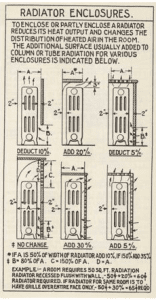Improve the efficiency of your heating system in less than an hour
Here are some indoor changes you can make to help your heating system give you the most it can.
1. Clean the darned things! No matter what heating type you have, dust interferes with the heat getting into your room.
Hot air: Your furnace has a filter, sometimes two. If the filter is grey, it is dusty. Paper filters get replaced, cloth/fiber ones can be washed. Look for them in slots near where the ducts meet the furnace or on the big return grate.
 Baseboards: Dust and hair find their ways into these. Remove the covers and vacuum.
Baseboards: Dust and hair find their ways into these. Remove the covers and vacuum.
Radiators:
Paint: Silver paint conducts heat best, if you paint your radiators use that. If the previous owners painted them a thousand times, strip them before repainting.
Covers: Most radiator covers reduce heat flow and are not helping you get the room warmed up. But, they are even worse when they are dirty. A vacuum cleaner or a damp rag can help open the air holes that are full of dust and hair.
2. Remove obstacles to air flow.
Hot air: Last week, I mentioned that hot air vents often get blocked by mats, rugs or furniture. They also get closed. If a room is cold, check that the vent is open. First look in the room at the vent itself. Some have louvers. The check the ducts coming from the furnace. There are levers along the duct someplace. The “on” position is parallel to the duct; the “off” is perpendicular. Find it. Check it. Test it to see if it changed the air flow. (Some old houses have broken levers.)
 Baseboards: Electric baseboards get pretty hot. Nothing should touch them. Keep furniture and drapes well away from electric heaters. Even hot water baseboards need room to breathe. They work by convection. Cool air rises past the heated pipe and baffles and comes out through the slot at the top edge of the baseboard. They need air flow from below them to rise as it is heated. Don’t block them with furniture or you can slow down the convection. Leaving about four inches should suffice. PS, make sure that slot is open. (You’d be surprised how many people don’t notice that it is closed.)
Baseboards: Electric baseboards get pretty hot. Nothing should touch them. Keep furniture and drapes well away from electric heaters. Even hot water baseboards need room to breathe. They work by convection. Cool air rises past the heated pipe and baffles and comes out through the slot at the top edge of the baseboard. They need air flow from below them to rise as it is heated. Don’t block them with furniture or you can slow down the convection. Leaving about four inches should suffice. PS, make sure that slot is open. (You’d be surprised how many people don’t notice that it is closed.)
Radiators:
Paint: Silver Terra cotta paint conducts heat best, if you paint your radiators use that. If the previous owners painted them a thousand times, strip them before repainting.
Updates on this information from one of my clients: He read the Bible about green steam heat, Greening Steam. He understands steam heat like many plumbers don’t.
According to Dan Holohan, the right color for a radiator is not silver (aluminum bronze.) Removing layers of paint is still necessary. If you are going to paint, here is the skinny:
Best is Terra Cotta, which provides 103.8% efficiency, followed by white zinc or enamel paint at 101% efficiency. 100% efficiency is had with no paint or maroon japan or flat black paint. You lose efficiency with white lead paint allows for 99% efficiency; but you cannot legally buy it because of health risks to children. At 96% efficiency is green enamel, dull. At the bottom of his list are the metallic colors: Gold bronze allows only 81% efficiency and gold aluminum (my choice) allows only 80%. (My information came from plumbers.)
 Covers: Most radiator covers reduce heat flow and are not helping you get the room warmed up. But, they are even worse when they are dirty. A vacuum cleaner or a damp rag can help open the air holes that are full of dust and hair.
Covers: Most radiator covers reduce heat flow and are not helping you get the room warmed up. But, they are even worse when they are dirty. A vacuum cleaner or a damp rag can help open the air holes that are full of dust and hair.
Also updated from Dan Holohan, here are the covers that will help you and the ones that will you’re your efficiency. What you will notice is that examples 1, 3, and 4 are ones that don’t affect or improve heating. Others (especially typical #5 you see everywhere) actually reduce effectiveness by 30%.